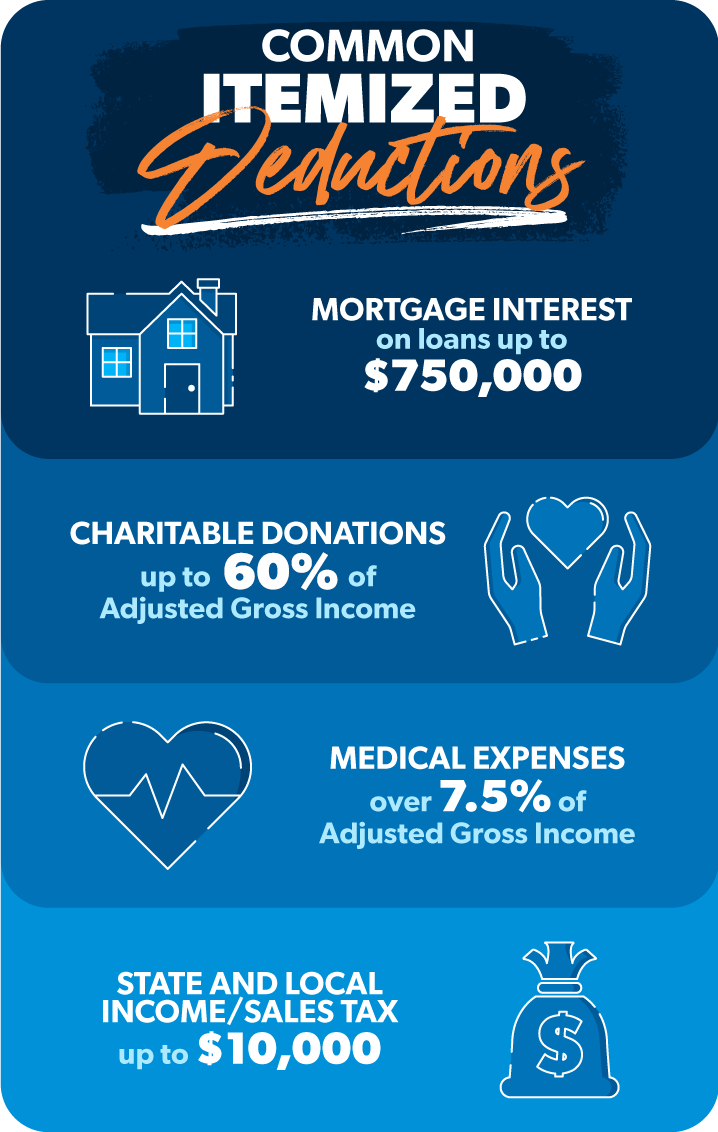Itemized vs. Standard Tax Deductions: Pros and Cons

When you’re filling out your taxes, it won’t be long before you’re faced with a decision: standard deduction or itemized deductions? You have to pick one!
A few years back, it was pretty common for taxpayers to itemize deductions. But in 2017, Congress nearly doubled the standard deduction, and that changed everything. For most people, the new standard deduction lowers taxable income by much more than itemized deductions. And that means it saves you more money on your taxes! About 87% of taxpayers now use the standard deduction instead of itemizing.1
But how do you know what’s best for you when you’re filing your taxes? We’ll take a look at the basics of standard and itemized deductions and some pros and cons of each.
What Is the Standard Deduction?
The main difference between a standard deduction and an itemized deduction is that a standard deduction is a set amount you can subtract from your taxable income when you file your taxes. Tax deductions are great because they lower your taxable income and that means a lower tax bill! The standard deduction is like an automatic tax freebie that’s based on your income, age and filing status: single, married or head of household.
Taxes shouldn’t be this complicated. Connect with a RamseyTrusted tax advisor.
For 2022, the standard deduction is $12,950 for single tax filers, $25,100 for married filing jointly, $12,500 for married filing separately, and $18,800 for head of household.2
Standard Deduction
| Filing Status | 2021 | 2022 | 20233 |
| Single | $12,500 | $12,950 | $13,850 |
| Married Filing Jointly | $25,100 | $25,900 | $27,700 |
| Married Filing Separately | $12,550 | $12,950 | $13,850 |
| Head of Household | $18,800 | $19,400 | $20,800 |
It might seem like a no-brainer to take the standard deduction, but let’s look at some of the pros and cons.
Pro:
Taking the standard deduction is fast and easy. It’s a single line item deducted from your gross income. You don’t have to dig through receipts and financial statements to find deductions to itemize. You simply elect to take the standard deduction.
Con:
You could pay more in taxes by taking the standard deduction if your itemized deductions add up to more than the standard deduction. We’ll talk about itemized deductions next.
Pro:
The standard deduction is much higher than it was a few years back. Congress nearly doubled the standard deduction when it passed the Tax Cuts and Jobs Act in 2017. Each year, the IRS bumps up the standard deduction a little bit to adjust for inflation.
Pro:
If you’re blind or over the age of 65, you get a higher standard deduction. It increases by $1,750 for single or head of household or $1,350 for married filing jointly.4 If you are both 65 and blind, the additional deduction is doubled.
Con:
You can’t use the standard deduction if you’re married filing separately and your spouse itemizes. So you and your spouse need to get on the same page! Also, if someone can claim you as a dependent, your standard deduction will be lower.
Pro:
If you aren’t planning to itemize, you can still deduct up to $300 ($600 for married filing jointly) of charitable contributions made in cash (this includes donations made by check and debit or credit card).5
What Is an Itemized Deduction?
An itemized deduction is a qualified expense you can subtract from your taxable income to lower your tax burden. Qualified expenses include the amount you paid for state and local income or sales taxes (up to $10,000), real estate taxes, personal property taxes, mortgage interest, charitable gifts and disaster losses from a federally declared disaster. You also can itemize a portion of your unreimbursed medical and dental expenses (any amount above 7.5% of your adjusted gross income).6 Though there are limits on specific types of deductions, the Tax Cuts and Jobs Act eliminated the limit on the total amount of itemized deductions you can claim.

If you have a home mortgage and pay a lot of interest and give generously to your church or another charity, your itemized deductions might add up to more than the standard deduction of $12,950 for single filers or $25,900 for married filers. If that’s the case, it will be worth it to itemize your deductions and skip the standard deduction.
Here are some pros and cons of itemizing deductions.
Pro:
You could save some money. If your itemized deductions are higher than the standard deduction, your tax bill will be lower. If you’re on the fence about whether or not to itemize, go ahead and plug the numbers into your tax-filing software or check with a tax pro to see which scenario will save you the most money.
Con:
It takes more time and paperwork to itemize deductions. Tracking down receipts for sales tax, medical expenses, interest expenses or charitable giving can be like looking for a needle in a haystack. What in the world did I do with that receipt for the box of clothes I gave to the homeless shelter?
When you itemize, you’ll have to fill out Schedule A and a few other tax forms to document your expenses. You also have to store all your receipts someplace safe. You don’t have to send them to the IRS when you file your taxes, but if you ever get audited and don’t have documentation, watch out! The dog ate my receipts won’t work with the taxman—especially if you don’t have a dog.
Pro:
If you itemize even slightly more deductions than the standard deduction, you’ll see a difference in your tax bill. Let’s say you’re married filing jointly, and you itemize $26,900 in deductions. That’s $1,000 more than the standard deduction, but that doesn’t mean you’ll save $1,000 in taxes. Remember, deductions are subtracted from your taxable income.
So in this example, itemizing deductions reduced your taxable income by $1,000. If you’re in the 22% tax bracket, that’s a tax savings of $220. For every dollar you deduct from your taxable income, you lower your tax bill by 22 cents.
Con:
It takes a pretty big pile of itemized deductions to top the standard deduction. Most of us won’t have more itemized deductions than the standard deduction. Like we said earlier, about 87% of taxpayers take the standard deduction.
Pro:
You can be rewarded for being really generous. For 2022, you can give up to 60% of your adjusted gross income (AGI) to qualified charities and receive a deduction for the full amount. In previous years, the IRS capped deductions for charitable contributions at 20% to 60% of AGI.7
When to Itemize vs. Take the Standard Deduction
Deciding whether to itemize or take the standard deduction boils down to one question: How can you save the most money on your tax bill? Hey, even if you only save 20 bucks by itemizing, wouldn’t having some extra money to save or pay down debt be worth it?
If you’re single and think you’re close to having more than $12,950 in deductions, go ahead and run the numbers. (Or have someone run them for you.) For you married folks, remember that number to beat is $25,900.
Other Tips to Get You Through Tax Season
Tax season 2023 is almost here, and the big deadline to file your taxes is April 18, 2023. But the sooner you start preparing for tax time, the better. As you receive interest statements, 1099s, W-2s and other documents, file them together in a safe place, so they’ll be right at your fingertips when you start working on your taxes.
If you’ve ever spent an hour digging through desk drawers and coat pockets searching for a missing receipt, you know the importance of keeping good, organized records. And that’s what it takes to itemize deductions when you file your taxes. Tax time is stressful enough. Don’t add additional stress to your life by waiting until the last minute.
Get Help With Your Taxes
If your taxes are pretty straightforward and you want an easy-to-use tax software that can give you some peace of mind, check out Ramsey SmartTax! No hidden fees, no advertisements, no games. That’s how it should be!
But what if you have a more complicated tax situation? In that case, working with a tax pro is a smart move. And if you’re looking for a RamseyTrusted tax expert in your area, Endorsed Local Providers (ELPs) have years of experience and can help you file your taxes with confidence. Find a tax pro today!
Source link





